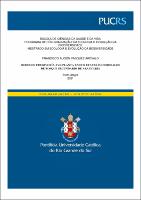| Share record |


|
Please use this identifier to cite or link to this item:
https://tede2.pucrs.br/tede2/handle/tede/9861| Document type: | Dissertação |
| Title: | Redes de frugivoría ave-planta en dos etapas sucesionales de bosque secundario de araucária |
| Author: | Arévalo, Francisco Alción Vásquez  |
| Advisor: | Ferreira , Pedro Maria de Abreu |
| Abstract (native): | Redes mutualísticas podem apresentar variações em sua estrutura dependendo dos estágios sucessionais da floresta. Nesta pesquisa avaliamos duas redes frugívoras na floresta secundária de araucária, e testamos como o estágio de sucessão pode influenciar na configuração das redes mutualísticas planta-ave, para isso categorizamos duas áreas de floresta secundária (inicial e avançada) de araucária na Reserva Particular do Patrimônio Natural Pró-Mata, Rio Grande do Sul, Brasil. Nessas áreas, coletamos fezes de pássaros por meio de redes de neblina para determinar os eventos de interação entre espécies de aves e plantas. Geramos redes bipartidas a partir de matrizes quantitativas e usamos descritores de nível de rede e espécies para comparações entre estágios de sucessão. Identificamos 23 espécies de aves (19 na rede inicial e 13 na rede avançada) interagindo com 14 espécies de plantas (11 na rede inicial e 10 na rede avançada). Destacou que a planta Myrsine lorentziana manteve sua representatividade estrutural, concentrando o maior número de interações com aves em ambos os estágios. As redes registradas eram mais especializadas e modulares do que o esperado ao acaso. A rede avançada apresentou maior grau de especialização (H2 '0,43) em relação à rede inicial (H2': 0,30); em relação à modularidade, a rede inicial apresentou maior grau (Q escore z: 6,55) em relação à rede avançada (Q escore z: 4,47). A especialização média em nível de espécie mostrou que as plantas tinham maior grau de especialização (d'inicial = 0,36 e avançado d' = 0,45) do que as aves em ambas as redes (inicial d' = 0,24 e avançado d' = 0,38). A abundância local das aves não mostrou relação com o grau de especialização, mas sim com o grau de interação na rede inicial. Duas espécies permaneceram no núcleo das espécies centrais entre as duas redes: M. lorentziana e Turdus albicollis planta e ave, respectivamente. Também detectamos que as aves migratórias faziam parte do núcleo das espécies principais em ambas as redes. Nossos resultados indicam que as florestas secundárias de araucárias avançadas abrigam redes de frugivoria menores, um pouco mais especializadas e menos modulares em comparação com a floresta em estágio inicial, que apresentou uma maior concentração de interações por uma espécie de planta. |
| Abstract (english): | Mutualist networks can present variations in their structure related to different degrees of specialization and organization of interactions. In the present investigation we evaluate two frugivorous networks in the secondary Araucaria forest, and we test how the succession stage influences the network size, level of specialization, modularity and species centrality. We categorized two areas of secondary forest (in initial and advanced successional stages) of Araucaria forest in at Reserva Particular do Patrimônio Natural Pró-Mata, Rio Grande do Sul, Brazil. In these areas we collected feces from birds captured in mist nets, to determine the interaction events between species of birds and plants. We generate bipartite networks from quantitative matrices and use species and network level descriptors for comparisons between succession stages. We identified 23 species of birds (19 in the initial network and 13 in the advanced network) interacting with 14 species of plants (11 in the initial network and 10 in the advanced network). It was remarkable that the Myrsine lorentziana plant maintained its structural representativeness in both stages. Observed networks were more specialized and modular than expected by chance. The advanced network presented a higher degree of specialization (H2': 0.43) compared to the initial network (H2': 0.30); with respect to modularity, the initial network presented a higher degree (Z-score: 6.55) compared to the advanced network (Z-score: 4.47). The average specialization at the species level showed that plants had a higher degree of specialization (d'initial: 0.36 and d'advance: 0.45) than birds in both networks (d'initial: 0.24 and d'advanced: 0.38). The local abundance of birds did not show a relationship with their degree of specialization, but with their degree of interaction in the initial network. Two species remained in the core of central species: M. lorentziana and Turdus albicollis, plant and bird, respectively. We also detected that migratory birds were part of the core species in both networks. We found that the secondary araucaria forests in advanced stage harbor smaller, slightly more specialized, and less modular frugivory networks compared to the forest in the initial stage, which present a higher concentration of interactions by a plant species. |
| Keywords: | Floresta Ombrófila Mista Planalto Comunidade de Aves Redes de Interação Rio Grande do Sul Mixed Ombrophilous Forest Planalto Bird Community Interaction Networks Rio Grande do Sul |
| CNPQ Knowledge Areas: | CIENCIAS BIOLOGICAS::ZOOLOGIA |
| Language: | por |
| Country: | Brasil |
| Publisher: | Pontifícia Universidade Católica do Rio Grande do Sul |
| Institution Acronym: | PUCRS |
| Department: | Escola de Ciências da Saúde e da Vida |
| Program: | Programa de Pós Graduação em Ecologia e Evolução da Biodiversidade |
| Access type: | Acesso Aberto |
| Fulltext access restriction: | Trabalho não apresenta restrição para publicação |
| URI: | http://tede2.pucrs.br/tede2/handle/tede/9861 |
| Issue Date: | 19-Aug-2021 |
| Appears in Collections: | Programa de Pós-Graduação em Ecologia e Evolução da Biodiversidade |
Files in This Item:
| File | Description | Size | Format | |
|---|---|---|---|---|
| Disertación mestrado_Francisco Alción Vásquez Arévalo.pdf | FRANCISCO_ALCIÓN_VÁSQUEZ_ARÉVALO_DIS | 2.67 MB | Adobe PDF |  Download/Open Preview |
Items in DSpace are protected by copyright, with all rights reserved, unless otherwise indicated.




